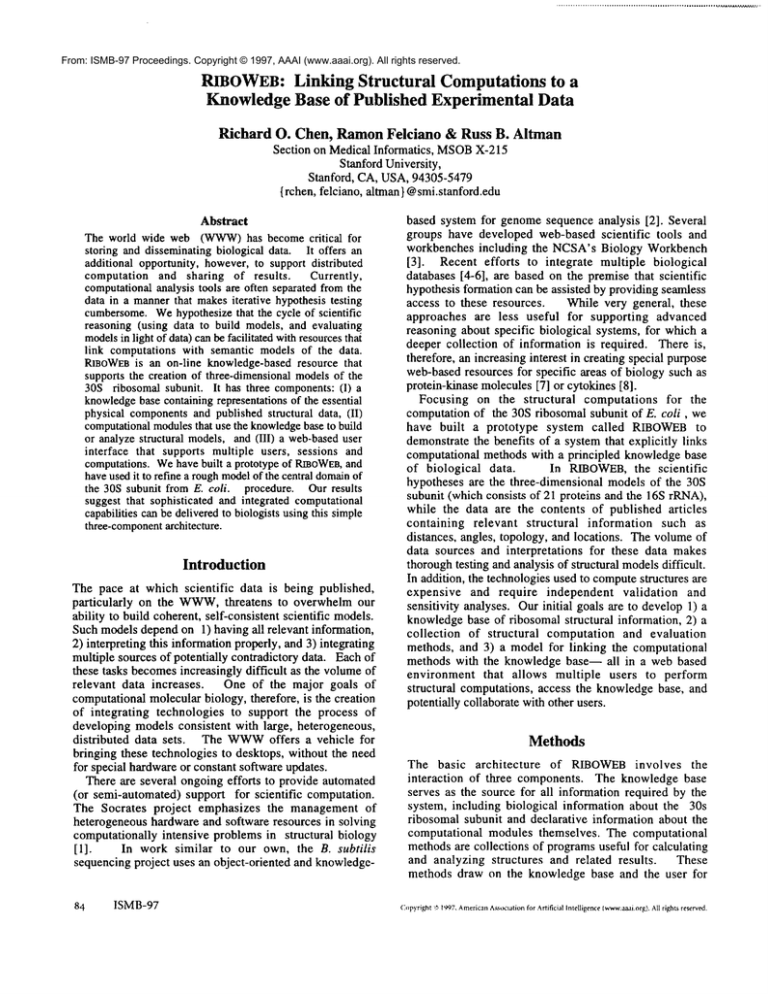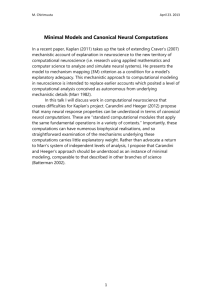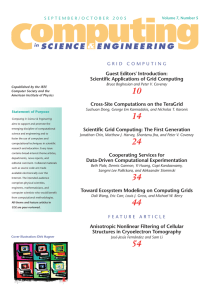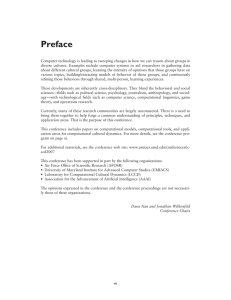
From: ISMB-97 Proceedings. Copyright © 1997, AAAI (www.aaai.org). All rights reserved.
RIBOWEB:Linking Structural
Knowledge Base of Published
Computations to a
Experimental Data
Richard O. Chen, RamonFeiciano & Russ B. Altman
Section on Medical Informatics, MSOB
X-215
Stanford University,
Stanford, CA, USA, 94305-5479
{rchen, felciano, altman} @smi.stanford.edu
Abstract
The world wide web (WWW)
has become critical for
storing and disseminating biological data. It offers an
additional opportunity, however,to support distributed
computation and sharing of results. Currently,
computationalanalysis tools are often separated fromthe
data in a mannerthat makesiterative hypothesis testing
cumbersome.
Wehypothesizethat the cycle of scientific
reasoning (using data to build models, and evaluating
modelsin light of data) canbe facilitated withresourcesthai
link computations with semantic models of the data.
RIBOWEB
is all on-line knowledge-basedresource that
supports the creation of three-dimensionalmodelsof the
30S ribosomal subunit. It has three components:(I)
knowledge
base containingrepresentations of the essential
physical comPonentsand published structural data, (II)
computationalmodulesthat use the knowledge
base to build
or analyze structural models, and (III) a web-baseduser
interface that supports multiple users, sessions and
computations.Wehave built a prototype of RIBOWEB, and
haveusedit to refine a roughmodelof the central domainof
the 30S subunit from E. coli. procedure. Our results
suggest that sophisticated and integrated computational
capabilities canbe deliveredto biologists usingthis simple
three-component
architecture.
Introduction
The pace at which scientific data is being published,
particularly on the WWW,
threatens to overwhelm our
ability to build coherent, self-consistent scientific models.
Such models dependon 1) having all relevant information,
2) interpreting this informationproperly, and 3) integrating
multiple sources of potentially contradictory data. Each of
these tasks becomesincreasingly difficult as the volumeof
relevant data increases. One of the major goals of
computationalmolecular biology, therefore, is the creation
of integrating technologies to support the process of
developing models consistent with large, heterogeneous,
distributed data sets. The WWW
offers a vehicle for
bringing these technologies to desktops, without the need
for special hardwareor constant software updates.
There are several ongoing efforts to provide automated
(or semi-automated) support for scientific computation.
The Socrates project emphasizes the management of
heterogeneous hardware and software resources in solving
computationally intensive problems in structural biology
[1].
In work similar to our own, the B. subtilis
sequencing project uses an object-oriented and knowledge-
84
lSMB-97
based system for genomesequence analysis [2]. Several
groups have developed web-based scientific tools and
workbenches including the NCSA’sBiology Workbench
[3]. Recent efforts to integrate multiple biological
databases [4-6], are based on the premise that scientific
hypothesis formation can be assisted by providing seamless
access to these resources. While very general, these
approaches are less useful for supporting advanced
reasoning about specific biological systems, for which a
deeper collection of information is required. There is,
therefore, an increasing interest in creating special purpose
web-basedresources for specific areas of biology such as
protein-kinase molecules[7] or cytokines [8].
Focusing on the structural
computations for the
computation of the 30S ribosomal subunit of E. coli, we
have built a prototype system called RIBOWEB
to
demonstratethe benefits of a system that explicitly links
computational methods with a principled knowledgebase
of biological data.
In RIBOWEB,
the scientific
hypotheses are the three-dimensional models of the 30S
subunit (which consists of 21 proteins and the 16S rRNA),
while the data are the contents of published articles
containing relevant structural information such as
distances, angles, topology, and locations. The volumeof
data sources and interpretations for these data makes
thoroughtesting and analysis of structural modelsdifficult.
In addition, the technologies used to computestructures are
expensive and require independent validation
and
sensitivity analyses. Our initial goals are to develop 1)
knowledgebase of ribosomal structural information, 2)
collection of structural computation and evaluation
methods, and 3) a model for linking the computational
methods with the knowledge base-- all in a web based
environment that allows multiple users to perform
structural computations, access the knowledgebase, and
potentially collaborate with other users.
Methods
The basic architecture
of RIBOWEB
involves the
interaction of three components. The knowledge base
serves as the source for all information required by the
system, including biological information about the 30s
ribosomal subunit and declarative information about the
computational modules themselves. The computational
methodsare collections of programsuseful for calculating
and analyzing structures and related results. These
methods draw on the knowledge base and the user for
(5~pyright ~, 1997, AmericanA~mtionfor Artificial Intelligence [www.aaai.org).All rights re~erved.
information it needs to perform the various calculations.
The user interface consists of the session manager (to
handle current and past computational results) and the
interface generator which provides web based user access
to the system. These moduleswork in concert to provide a
web based environment for doing structural computations
(Figure 1).
ComputalJonal
Methods
KnowledgeBase
\
Session
Manager
Interface
Generator
i
SeI~tN"
Clle~nta
Figure 1. The overall architecture
of RIBOWEB.
The
knowledge base, computational modules and sessionmanager/interface generator are on the server side (though
each maybe on a different computer). Multiple clients can
communicate with the interface generator to perform
computations or browse the knowledge base. In the
current implementation, the interface generator runs in
PERL. Computational modules run on a separate UNIX
workstation in C, C++, PERLor LISP. The knowledge
base is written in PERL,and most communicationis done
via HqTP.
The Knowledge Base
The knowledgebase is a repository for information about
the structural elements of the ribosome, as well as
experimental observations about structure. Weuse a
knowledge representation
schema that captures the
hierarchical nature of biological concepts. For our initial
prototype, we built a knowledgerepresentation tool called
VKB(Virtual KnowledgeBase) using the PERLlanguage.
VKBis a frame-based knowledge representation system
similar to CLIPS, CLASSICor ONTOL1NGUA
[9] that
allows us to define a schemaof conceptsand their attribute
names and types. Most entries in the knowledgebase are
instances of these objects associated with specific attribute
values. VKBcan be accessed in read/write mode both
through direct procedure calls and through a webaccessible CGIinterface.
The prototype RIBOWEB
knowledge base contains
structural data from eighteen published papers, chosen for
their relevance to our central domaincalculations. These
papers report experimental observations about proximity
between RNAbases or between the RNAbases and the Sproteins. The knowledgebase also contains the Cartesian
coordinates for previously reported models of the 30S
subunit, the published relative positions of the 21 proteins
in the 30S subunit, and the primary and secondarystructure
information for the 16S RNA. The key advantage of
frame-based representations is the ability to provide
multiple links between concepts to create a network of
useful information.
The RIBOWEB
knowledgebase also contains declarative
information about the computational methods. Each
methodis represented as an object containing a description
of the input and output data types of the method. These
descriptions resembles a primitive distributed object
representation, such as CORBA
[10], and have similar
advantages. First, we can incorporate computational
moduleswritten in different languages. Second, the task
of using these computational methodsis simplified since
we need only knowhowto get the necessary input to the
method, how to store the output from the method, andhow
to run the method.
The Computational Methods
A computational method can be single program or a
combination of several programs working to produce a
result.
The RIBOWEB
knowledge base contains an
explicit representation of the data types required for input
and produced as output for each method. The invocation
of a methodwith a set of particular input parameterscauses
the session manager to issue a unique "computation ID"
that identifies this particular computationand allocates file
space for the computation. All the resulting output is
stored in this file space, including the input parameters.
Thus, an audit trail is kept of all computations,and results
from previous computations can be accessed at any time
and used for future computation.
Whenbeginning a calculation, the session manager
queries the knowledge base for information about the
method being invoked. The method description contains
parametersdescribing the nature of the inputs including the
variable name, variable type (for example: knowledge
base class, enumeratedtype, or text), and default values.
Using this method description, the interface generator
dynamically generates an HTML
page that lists each
required variable, and an appropriate widget for acquiring
the value. Oncethe input values are obtained, the session
manager spawns a process that runs the computational
module. At the same time, the system creates a URL
where the results of the computational module can be
Chen
85
accessed upon completion. Someof these results can be
used as starting points for newcomputations.
Our prototype has ten methodsfor computingstructure
and analyzing results. The main computational method is
a probabilistic constraint satisfaction algorithm that
computesthe "most likely" position for each atom given a
set of uncertain distance constraints,
starting map
coordinates, and the uncertainties associated with those
values [11]. The analysis modules range from those that
find the constraints that are least well satisfied by a model
to those that generate fully hyperlinked 3D graphical
models in VRML.
The Interface Generator and Session Manager
The most of the functionality of the interface generator has
been discussed in the context of the other modules. The
interface generator is independent of the other modulesin
the sense that it is not affected by adding or changing
information in the other componentsof the system.
To support a multi-user environment, we distinguish
public and privately accessible information. The biological
data described above comprise the core of the knowledge
base, and are made "public" to all users. However, any
new data created by a user through direct editing of
knowledgebase information or through new computations
is automatically tagged with that user as the owner. Any
given user will only have access to the "public" data and
his or her own"private data" in the knowledgebase. This
allows users to imposetheir owninterpretations on the data
and pursue different lines of experimentation. Users can
also share the results of their computations,and this shared
information can be used by others to perform additional
analysis and computations. RIBOWEB
tracks each login
session, so user data is available for performance
monitoringand user interface validation.
Results: The Structure of the 30S Central
Domain
The 30S central domainis composedof bases 567 to 883 in
E. coli, and represents about 20%of the entire 30S subunit.
It is of particular interest because it is evolutionarily
conserved, and contains a number of antibiotic binding
sites. Wehave published two low resolution structures of
this domain [11, 12]. Weused RIBOWEB
to refine our
most recent model by including additional RNAbases not
previously modeled. Through a series of computations we
improvedthe structure from an initial average constraint
error of 10.9 SD(standard deviations from target value)
a final average error of 0.07 SD. The final structure has
good convergence.
Wewere able to use RIBOWEB
to externally validate
our models. The computed RMSdistance from other
models in the knowledge base averaged 31.6A which is
similar to the 36.6A reported between other models. [12,
13]. Furthermore, we found the structure to be consistent
with data from seven published data sets not used in our
86
ISMB-97
refinement.. In these data sets, the 15 constraints relevant
to the central domainwere on average within 2.7 standard
deviations error. On the other hand, the structure was
relatively inconsistent (> 6.63SDs) with constraint data
fromthree papers. It is clear that thoughthis structure is
reasonable, significant issues must be resolved before a
refinement at this level of detail can be accepted as a
consensusstructure.
Discussion
RIBOWEB,
despite being a prototype system, is capable of
supporting real structural computations and detailed
analysis of the results. In our experiments, we performed
three cycles of structural modelgeneration, refining the
interpretation of the data after each cycle. The structural
models were internally and externally evaluated using
computational modules closely coupled with the
knowledge base. RIBOWEB
does not aim to completely
automate the process of ribosomal modelbuilding; rather,
it begins to provide a web-based computational
environment that supports the user in formulating
computations, visualizing results, and sharing results. The
chief advantage of linking computationalcapabilities with
a knowledgebase of objects and associated data is the
ability to define an explicit context for both the inputs and
outputs of the computations. For example, we were able
to quickly identify problematicstructural regions by asking
the system which constraints were not well satisfied, and
then visualizing the structures involved in those
constraints.
Our results further suggest that the web is an adequate
environment for supporting complex computations. By
designing the system to be web based, we are bound by
someof the web’scurrent limitations (such as its stateless
nature), but we have demonstrated that these limitations
are not enoughto prevent the creation of a usable system
over the web.
To accommodate future enhancements, R1BOWEB
has
been built in a modular fashion and can be incrementally
upgraded. The VKBknowledge base is being redesigned
using the ONTOLINGUAnetwork-based
frame
representation system. The computational modules could
be written in JAVAor as CORBA
objects, with their
associated languages for specifying the input/output
interface. The session managerand interface generators
can be replaced by database management systems and
more biology-friendly user interfaces like SSTRUCTVIEW,
a interactive java applet displaying RNAsecondary
structures that are hyperlinked to various information
sources across the web, including the VKB[14]. Common
graphical idioms like this may serve as more intuitive
interfaces to parts of the RIBOWEB
system. With these
opportunities for improvement, we believe that these
replacement technologies will only lead to a more robust
and powerful integrated system.
Our results in this paper also expose some of the
problems with the current RIBOWEB
system. First, we
have not demonstrated the ability to link RIBOWEB
to
other web-based databases (like the Ribosomal Database
Project, RDP) in order to support more diverse data
analysis and combination. We have shown (Altman,
Abernethy, Chen, in this volume) that the RIBOWEB
knowledge base component can be linked to the RDPin
order to generate useful structural inferences, but we must
next demonstrate that distributed information sources can
be fully integrated into the RIBOWEB
system. The second
major limitation in RIBOWEB
is the lack of support for
informal communication between users and a mechanism
for annotating results.
We have not designed this
prototype system to be a sophisticated collaboratory
environment. It may be necessary to allow concurrent
visualizations of data and structures through interactive
VRMLwindows and whiteboards to make RIBOWEBa
robust collaboratory environment.
Conclusions
Wehave described a prototype system for supporting
integrated hypothesis formation and evaluation that
demonstrates 1) the feasibility of coupling computational
methods with an underlying
knowledge base of
information, 2) the suitability of the webto support this
computing environment and the potential for sharing of
results, and 3) the utility of such a system in computing
ribosomal structure. RIBOWEB
is a prototype of what may
become a useful central repository for new ribosomal
swactural data, and a tool for checking the consistency of
new data with published structural data and models. It also
provides a place where new computational methods could
be integrated and madewidely available. Eventually, our
architecture maybe abstracted to provide general purpose
computational support in other areas of computational
biology. A demonstration version of RIBOWEB
can be
accessed at http://www-smi.stanford.edu/projects/helix/
pubs/ismb97-cfa/.
Acknowledgments
Wethank Lawrence Hon and Neil Abernethy for useful
feedback, Harry Noller for access to data, and ChengChe
Chenfor efficient code for structure calculation. This work
is supported in part by NIH-LMG5652,LM06442, and
LM-07033,NSF DBI-9600637, and a grant from IBM.
3. Fischman, J., Workingthe WebWith a Virtual Lab and
SomeJava. (1996). Science, 273(2 August 1996):
591-593.
4. Etzold, T., Ulyanov,A., &Argos, P., SRS: Information
Retrieval System for Molecular Biology Data Banks.
(1996). Methodsin Enzymology,266: p. 114.
5. Buneman,P., Davidson, S.B., Hart, K., Overton, C., &
Wong, L., eds. A Data Transformation System for
Biological
Data Sources Proceedings of 21st
International Conference on Very Large Data Bases.
1995: Zurich, Switzerland.
6. Buneman,P., Naqvi, S., Tannen, V., & Wong,L.,
Principles of Programmingwith ComplexObjects and
Collection Types. (1995). Theoretical Computer
Science, 149(1): p. 3-48.
7. Bourne, P., Gribskov, M., Ten Eyck, L., &Taylor, S.,
PKDB:The Protein Kinase Database Project. (1996).
Protein Data Bank Quarterly Newsletter, 77: p.
http:llwww.pdh.hnl.govlnewslttrltxtlnewslttr.txt~u196.
8. Allen, G., Patrick, T., & Murtaugh, M. World Wide
Web-basedaccess to heterogenous information
resources for cytokine research, in 20th Annual AMIA
Fall Symposium. 1996. Washington, D.C.: American
MedicalInformatics Association.
9. Karp, P.D., The design space of frame knowledge
representation systems, 1992, SRI International
Artificial Intelligence Center.
10.Achard, F. & Barillot, E., Ubiquitous Distributed
Objects with CORBA, in Pacific Symposium on
Biocomputing,1997, R.B. Altman, et al., Editors. 1997,
WorldScientific: Singapore.p. 39-50.
1 l.Altman, R.B., A probabilistic approach to determining
biological structure: integrating uncertain data sources.
(1995). Int. J. Human-Computer
Studies, 42: p. 593616.
12.Fink, D.L., Chen, R.O., Noller, H.F., &Altman, R.B.,
Computational methods for defining the allowed
conformational space of 16S rRNAbased on chemical
footprinting data. (1996). RNA,2: p. 851-866.
13.Malhotra, A. & Harvey, S.C., A Quantitative model of
the E. coli 16S RNAin the 30S Ribosomal Subunit
(1994). J Mol Bio, 240: p. 308-340.
14.Felciano, R.F., Chen, R.O., & Altman, R.B., RNA
secondarystructure as a reusable interface to biological
information resources. (1996).Gene-COMBIS,
in press:
http://www1.elsevier.nl/journals/genecombis/jnl/articles
/S0378111996008554/.
References
1. Costian, C. &Marinescu, D., Socrates: An Environment
for High Performance Computing. (1995). IEEE, : p.
199-206.
2. Medigue, C., Vermat, T., Bisson, G., Viari, A., &
Danchin, A. Cooperative computer system for genome
sequence analysis, in Third International Conferenceon
Intelligent
Systems for Molecular Biology. 1995.
Cambridge, England: AAAIPress.
Chen
87





